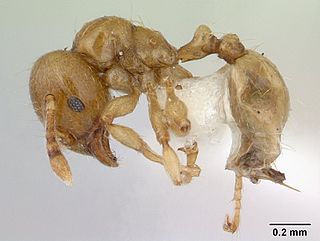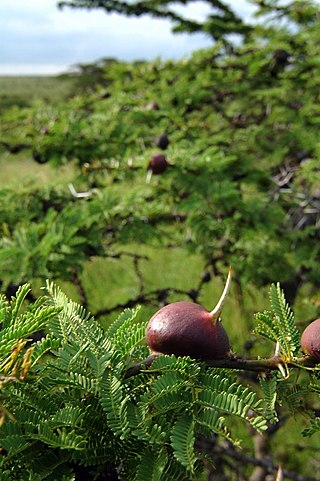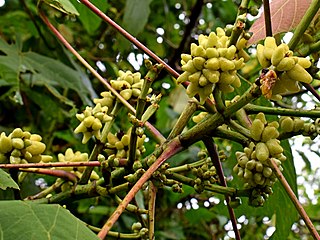
Allomerus decemarticulatus is an Amazonian ant species found in the tropics of South America. This species is most notable for the workers’ complex and extreme predatory behavior, which involves a symbiosis with both a plant and fungal species. They live in leaf pockets of a host plant species, Hirtella physophora. These leaf pockets are areas inside of the plant between the leaves and the stem. Each colony, which consists of about 1,200 workers, inhabits a single tree; however, the ants are spread among the leaf pockets, with typically 40 workers per pocket. Their diet primarily consists of large insects that are captured on the plant, but they also eat some kinds of food bodies produced by the plant as well as its nectar. They are able to capture their prey, which is much larger than themselves, by constructing a platform that acts as a trap for the unsuspecting prey. The ants hide in the trap and attack when any insect lands on it. This technique is an example of ambush predation.

Myrmecophytes are plants that live in a mutualistic association with a colony of ants. There are over 100 different genera of myrmecophytes. These plants possess structural adaptations that provide ants with food and/or shelter. These specialized structures include domatia, food bodies, and extrafloral nectaries. In exchange for food and shelter, ants aid the myrmecophyte in pollination, seed dispersal, gathering of essential nutrients, and/or defense. Specifically, domatia adapted to ants may be called myrmecodomatia.
Myrmelachista schumanni, also known as the lemon ant, is a species of ant from South America. It is notable for the creation of devil's gardens. Using its own herbicide, they kill off all the plants in an area except for the myrmecophytes, or ant-plants, in which they reside.

Vachellia collinsii, previously Acacia collinsii, is a species of flowering plant native to Central America and parts of Africa.

Myrmecophily is the term applied to positive interspecies associations between ants and a variety of other organisms, such as plants, other arthropods, and fungi. Myrmecophily refers to mutualistic associations with ants, though in its more general use, the term may also refer to commensal or even parasitic interactions.

Vachellia drepanolobium, more commonly known as Acacia drepanolobium or whistling thorn, is a swollen-thorn acacia native to East Africa. The whistling thorn grows up to 6 meters tall. It produces a pair of straight spines at each node, some of which have large bulbous bases. These swollen spines are naturally hollow and occupied by any one of several symbiotic ant species. The common name of the plant is derived from the observation that when wind blows over bulbous spines in which ants have made entry and exit holes, they produce a whistling noise.

A domatium is a tiny chamber that houses arthropods, produced by a plant.
Devil's Garden or Devils Garden may refer to:

The acacia ant is a species of ant of the genus Pseudomyrmex. These arboreal, wasp-like ants have an orange-brown body around 3 mm in length and very large eyes. The acacia ant is best known and named for living in symbiosis with the bullhorn acacia throughout Central America.

Duroia is a genus of flowering plants in the family Rubiaceae. The genus is found from Costa Rica to tropical South America.

Duroia hirsuta is a myrmecophyte tree species from the Amazon Forest. It is one of some 37 species of Duroia, which are shrubs or canopy trees in the family Rubiaceae, favouring ants (myrmecophilous), and occurring in Central America as far north as Mexico, the Amazon Basin, the Guiana Shield, the Brazilian Atlantic coast and planalto.

Pearl bodies are small, lustrous, pearl-like food bodies produced from the epidermis of leaves, petioles and shoots of certain plants. They are rich in lipids, proteins and carbohydrates, and are sought after by various arthropods and ants, that carry out vigorous protection of the plant against herbivores, thus functioning as a biotic defence. They are globose or club-shaped on short peduncles, easily detached from the plant, and are food sources in the same sense as Beltian bodies, Müllerian bodies, Beccarian bodies, coccid secretions and nectaries. They occur in at least 19 plant families (1982) with tropical and subtropical distribution.

Azteca alfari is a species of ant in the genus Azteca. Described by Carlo Emery in 1893, the species is widespread in Mexico, Central and South America. This ant has a mutualistic relationship with a Cecropia tree. The specific name alfari honours a Costa Rican zoologist Anastasio Alfaro.

Hydnophytum formicarum, commonly called a "Baboon's head" or "Ant plant", is an epiphyte native to Southeast Asia and is considered critically endangered in Singapore. It is a myrmecophyte as ants live in its tuber, also known as a caudex, and pollinate its flowers. It resides in open-canopied areas, rainforests, and terrestrial regions of high elevation.

Macaranga triloba is a species of plant in the family Euphorbiaceae. It is native to the tropical forests of southeastern Asia. It is a pioneer species, colonising recently cleared or burnt areas of the forest.
Tetraponera penzigi, is a species of ant of the subfamily Pseudomyrmecinae, which can be found in East Africa. It forms an obligate symbiosis with the whistling thorn acacia, a dominant tree in some upland areas of East Africa.
Barteria fistulosa is a species of tree in the family Passifloraceae, native to tropical Central Africa. The tree has an association with an aggressive species of ant with a very painful sting, which lives in its hollow branches and twigs, and gives rise to its common name of "ant tree".
Tetraponera tessmanni is a species of ant in the subfamily Pseudomyrmecinae, which is native to tropical Central Africa, where it inhabits the hollow stems of the liana Vitex thyrsiflora.
Vitex thyrsiflora is a species of woody vine in the family Lamiaceae. It is native to tropical West and Central Africa. Its hollow stem is used as a home by an aggressive species of ant.
Megan Frederickson is a Canadian evolutionary biologist who is a professor of Ecology and Evolutionary Biology at the University of Toronto. Her research considers the evolution of cooperation and the ecological genetics of mutualism.













